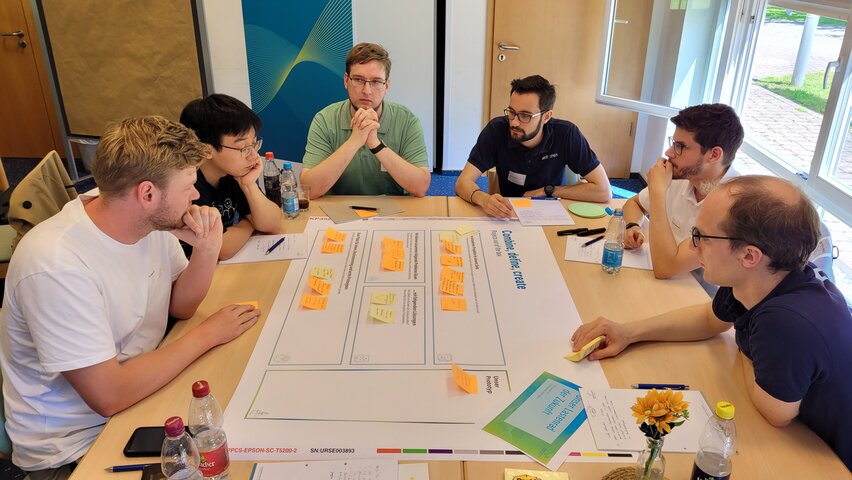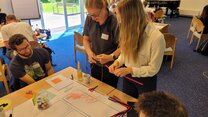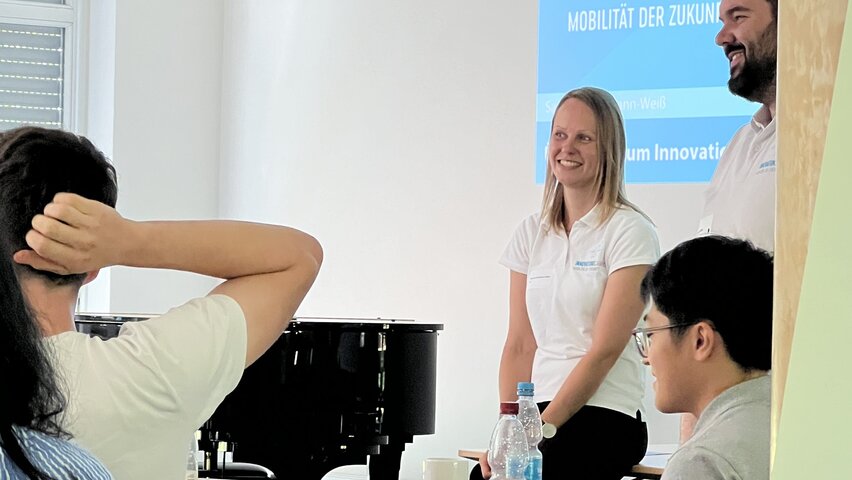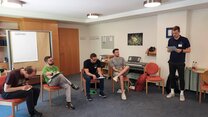The vision of the future consists of pom-poms, pipe cleaners, and paper. The small robot is a marvel of modular design. Depending on its configuration, it can grasp, cut, weld, manufacture additively, measure distances and temperatures, and much more. It can also talk and accompany colleagues to lunch or care for sick people after work. Of course, it is just a fantasy product, a fragile craft project. It almost crumbles in the hands of Johannes Wahl as he presents the idea during the ICM seminar for doctoral candidates and postdocs, an idea that his working group — one of five —developed during the introductory phase. However, theoretically, the five researchers from different fields could one day jointly develop the modular robot. This makes it an example of the diversity, interdisciplinarity and creativity of the ICM doctoral community, just like the results of the other four teams.

Combine, define, create
How much creativity is present in the researchers of the ICM? Answers to this question were provided at the ICM seminar for doctoral candidates in Bad Liebenzell. During the two-day event in Monbachtal, members of the ICM doctoral community gathered to exchange research findings and international experiences and to deepen their knowledge in interactive workshops.
"I have mainly learned that I am not an exception within the ICM, but rather the norm," shares Anjela Mayer from the Institute for Information Management at the Karlsruhe Institute of Technology. She works on software- and data-driven technologies—Extended Reality (XR) in production—and values the exchange in an international research network. This combination applies to many of the 27 seminar participants, and in Anjela’s five-member working group, it applies to the majority. Jantje Marie Schlömer is developing a model to predict costs and environmental impacts of batteries for future mobility. Tonja Heinemann is working on software that facilitates the creation of company-specific Open Platform Communications Unified Architecture (OPC UA) solutions. Marc Schindewolf focuses on integrated approaches for the software development of upgradeable vehicles. For the lasers Johannes Wahl works on to one day become part of a universal machine, data-driven control systems are also necessary. All five have international experiences listed in their CVs, including semesters abroad, presentations at international trade shows or conferences, or even research semesters abroad. Anjela Mayer was at the Vicomtech Computing Center in Spain, and Johannes Wahl was at the National Institute for Standards and Technology in Boulder, USA, both as part of Short-term Grants for Talents from the ICM.
Looking at the other working groups, it also becomes clear that the ICM doctoral community is spread across Baden-Württemberg. The participants come from 15 institutes at three universities: the Karlsruhe Institute of Technology, the University of Stuttgart, and Aalen University. "At the ICM, researchers from many different institutes and disciplines work together. Being able to meet here to get to know each other, expand our networks, and hear new perspectives on our research topics is very beneficial for us," explains Jantje Marie Schlömer from the Institute for Work Science and Technology Management at the University of Stuttgart.
The results of the five working groups prove how valuable diversity and a wealth of perspectives are for collaboration among researchers. "We are all working on different topics. Nevertheless, each team found enough overlap to develop interesting ideas that were enhanced through teamwork," says Sebastian Funken from the Laser Application Center at Aalen University. The fact that the modular robot, the universal machine in the truck, the vehicle controlled by a movable battery, the connected factory of the future, or the cloud-based network of autonomous cargo bikes are merely spontaneous ideas is not important. "What matters is that it has fostered a network mindset. We had much better conversations during the creative work than in other seminars with many presentations," says Jantje Marie Schlömer. What she also expresses is that the event has already achieved its most important goal by the end of the first program point



















